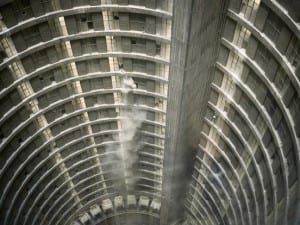Korean artist Park Seo-Bo receives his first solo exhibition in the UK at White Cube Mason’s Yard. Widely considered one of the leading figures in contemporary Korean art, alongside Lee Ufan and Kim Tschang Yeul, and credited as being the father of the “Dansaekhwa” or Korean Monochrome movement, he is best known for his Ecriture series of paintings which he began in the late-1960s. This exhibition traces the origins of these works and includes 16 paintings made from 1967-81.
Born in 1931 Park Seo-Bo was part of a generation that was deeply affected by the Korean War which split the country into North and South. After experimenting with Western abstraction, Park began to explore a more introspective methodology that had its origins in Taoist and Buddhist philosophy and also in the Korean tradition of calligraphy.
The artist has said of his approach: “My work is related to the oriental tradition of space, the spiritual concept of space. I am more interested in space from the point of view of nature. Even though my paintings may represent an idea about culture, the main focus is based on nature… I want to reduce the idea and emotion in my work to express only that. I want to reduce and reduce – to create pure emptiness.”
Also known as “Myǒbop” in Korean, which translates as “law of drawing” or the “way of drawing”, this approach is clearly demonstrated in Park’s Ecriture paintings, where he eliminates any form of gesture, focusing instead on a sense of dynamic continuity through repeated pencil lines which are incised into the painting’s monochrome surface. Executed in a single sitting, before the paint has time to dry, the works reflect a sense of immediacy and totality.
The paintings demonstrate the persistence of the monochrome since, despite these regular incisions into the white paint, from a distance they appear to be only one colour, or perhaps, an empty painting. Park’s use of white is fundamental, since it acts as a signifier of immateriality in Korea, often representative of sun and light. Conceived in a fleeting moment, Park’s calligraphic marks reflect his interest in reaching a sense of “pure emptiness”, an attempt that is made afresh with each new painting.
Park Seo-Bo, Ecriture 1967-1981, until 12 March, 25-26 Masons Yard, London, SW1Y 6BU.
Find out more: www.whitecube.com.
Follow us on Twitter @AestheticaMag for the latest news in contemporary art and culture.
Credits
1. Park Seo-Bo, Ecriture (描法) No. 15-76, 1976. Pencil and oil on canvas, 51 7/16 x 63 3/8 in. (130.7 x 161 cm). Photo: White Cube (George Darrell).





